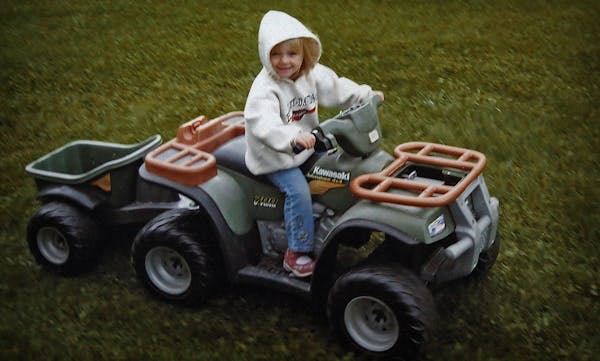Misty Eystad's life flashed before her eyes as she ran toward her daughter's motionless body.
It was July 4th weekend in 2017 at the cabin of a family friend. Before breakfast, the kids jumped onto a side-by-side ATV for a casual ride. Chalee, 13, was a passenger. Cale, her older brother, was the driver. When he turned to change directions, the vehicle rolled and pinned Chalee to the ground. Cale thought his sister was dead.
"When I came upon her she was not breathing and there was blood from her ears,'' Misty said. "I got down and talked to her, praying she would breathe.''
Recalling that moment of fright still brings tears. Chalee ultimately gasped for air and was flown from the Detroit Lakes area to North Memorial Health Hospital in Robbinsdale. A second helicopter took Cale, who badly fractured his shoulders, hands and wrists. Both children suffered lasting injuries, and Chalee's fate wasn't certain until she emerged from a weeklong, medically induced coma.
"We were fortunate, but it goes the other way,'' Misty said. "Kids die. People die.''
So far this year, an unprecedented surge in ATV ridership across Minnesota has led to 20 fatal accidents — more deaths than the state normally sees in a year. With fall hunting now contributing to one of the busiest periods of off-highway vehicle usage, the Department of Natural Resources is reminding riders to play it safe and heed safety precautions.
"One seemingly minor mishap can be the difference,'' said Jon Paurus, DNR Enforcement Division education program coordinator.
Starting in early March, Darrell Ness, 72, died from injuries he suffered on an early afternoon ride 3 miles west of Ashby. The Grant County Sheriff's Department said Ness was a passenger on an ATV that rolled. Since then, 19 riders and passengers as young as 9 have lost their lives in rollovers, collisions and vehicle ejections.
As sheriff's deputies and conservation officers continue to respond to accidents and a surge of complaints about the machines, they cite excessive speed, intoxication, lack of required safety training, underage driving, failure to obey traffic signs, and helmet violations as chronic problems. In addition, more ATV riders are driving where they shouldn't: paved roads, unauthorized private land and off-trail areas on public land.
"They're going wherever they want,'' said DNR conservation officer Amber Ladd. "I've never had this many issues or complaints.''
Ladd, who is based in McGregor, said too many people are riding ATVs without educating themselves. State law requires any prospective ATV rider born after July 1, 1987, to complete safety training before operating away from private land. For youth ages 10 to 15, the online course must be coupled with a one-day, hands-on skills class. Any person under age 18, including toddlers, babies and other passengers, must wear a properly fitted, Department of Transportation-approved helmet.
"Lots of adults don't realize they have to have training, and there's lots of kids on ATVs with no helmets,'' Ladd said.
Her territory inside Aitkin County hasn't experienced a fatal ATV accident this year, but Ladd said a serious crash over Labor Day weekend sent two people to the hospital. In that case, a dad and two kids were bucked off an ATV that took a corner too fast, she said.
According to this year's fatal accident statistics compiled by the DNR, six victims were younger than 20. Alcohol was cited as a factor in five of the 20 tragedies, and victims were not wearing helmets more than half the time. (The agency's report didn't specify if head injuries were the cause of death.)
The majority of crashes are happening on roads, not trails — a factor common in ATV deaths across the country. Safety tips published by the DNR list the avoidance of paved roads as one of the golden rules of ATV safety.
Minnesota has been expanding its off-road trail networks to accommodate legions of new riders. But manufacturers and enthusiasts say COVID-19 social changes have stirred more interest this year than ever.
Scott Wine, chief executive at Polaris Inc., said last month that demand for the company's off-road vehicles was unprecedented in May, June and July. The same torrid pace of sales has cut ATV inventories across the country. According to the September issue of Motorcycle & Powersports News, the boom stems from the perception that ATVs are an answer to the question: "How do I have fun during a pandemic?"
In Minnesota last year, the DNR recorded 329,275 registrations of off-highway vehicles. ATVs are the most popular type, and so far this year there are nearly 24,000 new registrations, the DNR said.
Travis Hetteen is president of an ATV riding club in Beltrami County called Northwoods Riders. He said off-road vehicle traffic is up across the board. Some people new to the sport are buying big machines before they have operating experience, he said.
He agrees that inexperience and lack of training are contributing to accidents. But he noted that DNR safety classes in Minnesota were shut down from March until early August because of the coronavirus. He said he was glad to see them return.
Current ATV models can weigh more than 800 pounds and achieve speeds in excess of 80 mph. But even at low speeds, they can roll, said Misty Eystad. Her safety message to other parents is to take every ride seriously.
Her daughter, Chalee, and son, Cale, weren't wearing seat belts or helmets when they crashed. Observers believe that the ATV was moving only about 10 mph when it tipped while making a U-turn.
"The tendency is to think they are going slow enough, they'll be fine,'' she said. "But no matter how fast you are going or how slow … anything can happen.''






